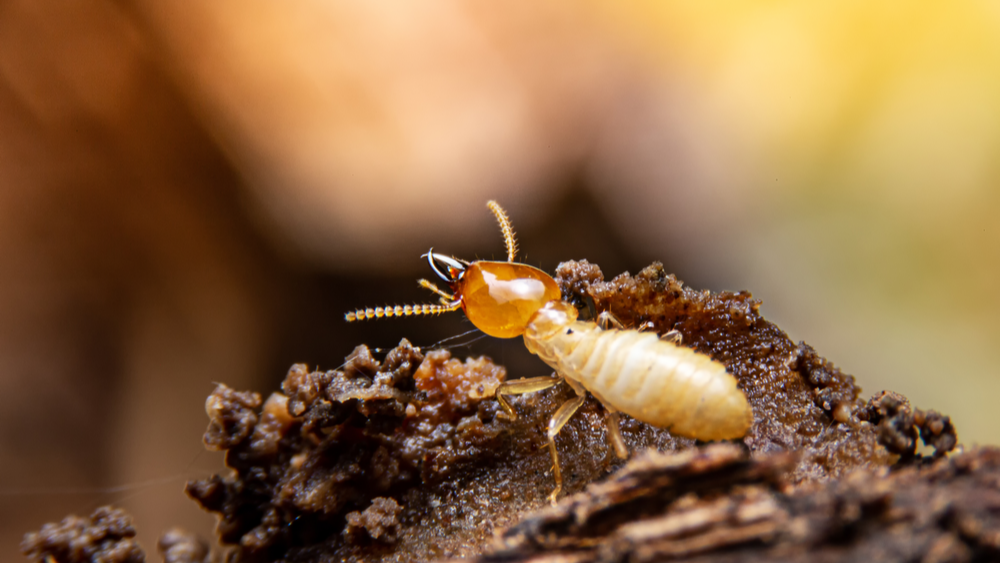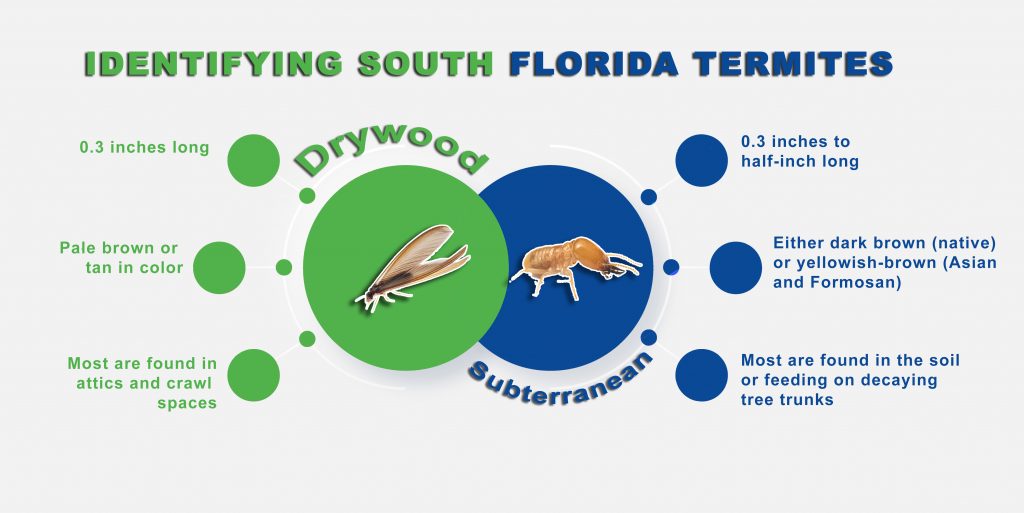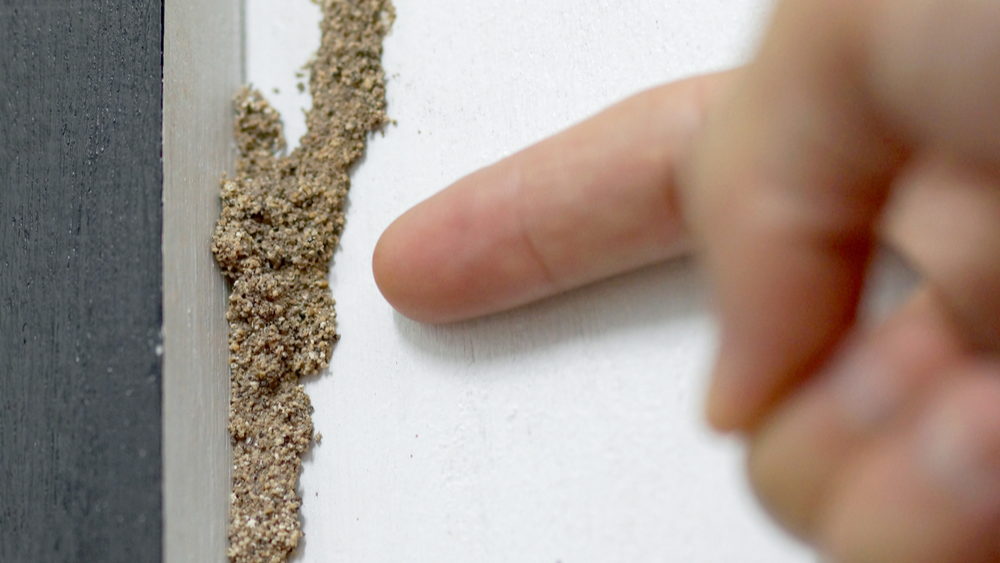
South Florida homeowners are rightly concerned about the threat posed to their homes by storms, floods, and fires. Yet, one tiny pest does more damage to structures in Florida than all of those natural disasters combined—termites.
The danger of a termite infestation is more perilous to homeowners in our region because home insurance policies don’t cover the cost of repairing the damage done by these insects. Good construction and regular maintenance can reduce the threat of termites, but the best way to keep these wood-eating pests at bay is by partnering with a trained and licensed pest control professional.
The first step in determining whether termites are present in or around your home is knowing how to spot them. This guide to Florida termite identification explains the distinctive characteristics of the termite species that are active in the region and that pose a threat to your property.
Florida Termite Identification: Facts and Figures
There are 21 different species of termites present in Florida, although only a handful of them cause damage to wooden structures. Six of those termite species are invasive, which is more than any other state. The termites that South Florida homeowners need to be concerned about are placed in four categories based on their lifestyle and habitat, which are:
- Subterranean termites include two native species and three invasive types. The natives are the
Eastern subterranean termite (scientific name Reticulitermes flavipes) and the Cuban subterranean termite (Prorhinotermes simplex). The invasive species in this category are the Formosan (Coptotermes formosanus), Asian (Coptotermes gestroi), and West Indian (Heterotermes) subterranean termites. - Drywood termites in the area are one of three types: Florida Drywood termites (Cryptotermes cavifrons) are native, while West Indian Drywood termites (Cryptotermes brevis) and Western Drywood termites (incisitermes minor) are invasive.
- Florida Dampwood termites (Neotermes castaneus) are a native species.
- Higher termites include the Florida Darkwinged subterranean termite (Amitermes floridensis) and the Conehead termite, which is also called the tree termite.

How to Identify Different Types of Termites in South Florida
The two types of termites that are most likely to damage homes in South Florida are Subterranean termites and Drywood termites.
Subterranean termites come up from the ground to feed on wood and can be voracious. While they prefer soft or damp wood, they’ll also feed on dry hardwood. These termites measure from about 0.3 inches to a half-inch long and are either dark brown (native) or yellowish-brown (Asian and Formosan). They generally stay out of sight and aren’t noticeable until their annual flights of winged termites, which are called alates.
The damage done by Subterranean termites usually doesn’t become apparent until it is severe. The termites tend to nest where damp wood meets soil and build mud tubes between the ground and the wood.
Drywood termites feed on hardwood such as window sills, door frames, and furniture. They are about 0.3 inches long and are pale brown or tan in color. These termites are sometimes called powderpost termites. They are easier to spot than Subterranean termites because of the feces they leave behind, which resembles sand, sawdust, or pellets. Drywood termites begin to swarm at dusk as the rainy season arrives in April and runs through July.
Tips for Detecting a Termite Infestation in Your Home
As Drywood termites swarm in search of a place to establish a colony, they bore into wood and leave behind small piles of debris called frass. These are among the methods used to detect Drywood termites:
- Listen for the clicking sounds the termites make as they communicate with each other.
- Watch for sand-like pellets or small piles of dust on window sills and other wood that indicates a “kick-out” hole that the termites use to eject waste.
- Knock on the wood with a hard object such as the end of a screwdriver and listen for a hollow sound compared to the solid sound you would expect to hear.
In addition to looking for the mud tubes that are characteristic of Subterranean termites, the best way to spot these pests on your property is by watching for swarmers and the wings that the swarmers have shed. Unlike Drywood termites, Subterranean termites feed on building insulation and cellulose in plants along with wood.

The Termite Laws of Attraction
Termite troubles are seemingly random, but there are a few things that make homes attractive to different types of termites.
Drywood Termites are drawn to homes primarily for 3 reasons: suitable wood, moisture, and warmth. Specific (and common) conditions that can make a home more conducive to those environments include:
- Unprotected or Damaged Wood: Drywood termites infest dry, untreated wood. They can enter homes through cracks, gaps, or openings in wooden structures such as siding, roofing, window frames, or door frames. If the wood is untreated or lacks a protective finish, it becomes more susceptible to termite infestation.
- Moisture Accumulation: While drywood termites can tolerate lower moisture levels compared to other termite species, they still require some moisture to survive. Areas of the home with excessive moisture, such as leaky pipes, faulty plumbing, or condensation issues, can create an attractive environment for drywood termites.
- Firewood and Wooden Furniture: Drywood termites can infest and spread through firewood or wooden furniture that is brought into the home. If the firewood or furniture already contains drywood termite colonies or eggs, they can introduce these troublesome pests to your property.
Subterranean Termites are drawn to homes for similar reasons: namely wood, moisture, and accessibility. To get more specific, here are some conditions that are especially appealing to subterranean termites:
- Wood as a Food Source: Subterranean termites primarily feed on cellulose material found in wood, and are attracted to structures that provide a source of nourishment. This includes wooden components of homes such as structural wood, wooden furniture, flooring, and even paper products.
- Moisture Accumulation: Subterranean termites require moisture to survive – excessive moisture in and around your home can create an attractive environment for these wood-gnawing menaces. Leaky pipes, faulty plumbing, improper drainage, or areas with high humidity can contribute to moisture buildup and increase the risk of termite infestation.
- Soil-to-Wood Contact: Subterranean termites build their nests in the soil and establish underground tunnels to access above-ground food sources. They are attracted to homes where there is direct contact between wood and soil, such as wooden posts, tree stumps, or untreated wooden foundations.
Accessibility and Entry Points: Subterranean termites can enter homes through small cracks, gaps, or openings in foundations, walls, or utility lines. They seek out vulnerabilities that provide easy access to the interior of a structure.
The Termite Prevention Roadmap
So we know the conditions that lead to a termite infestation can be pretty…regular. So how can you prevent them?
Preventing Drywood Termites includes:
- Regularly inspect and seal any cracks, gaps, or openings in wooden structures to deny entry points for termites.
- Ensure proper ventilation and minimize moisture accumulation in areas prone to dampness.
- Store firewood away from your home and raised off of the ground.
- Inspect any wooden items or furniture before bringing them into your home.
- Regularly maintain and treat wooden structures with appropriate wood preservatives or finishes.
Preventing Subterranean Termites, while similar, requires some different prevention priorities:
- Maintain proper drainage around your home to prevent water accumulation near the foundation.
- Repair any leaks or plumbing issues promptly to minimize moisture problems.
- Ensure there is no direct soil-to-wood contact, especially for structural elements.
- Regularly inspect and seal any cracks or openings in the foundation, walls, or utility entry points.
- Use treated wood or termite-resistant materials for construction and renovations.
- Consider installing a termite barrier or preventive treatment around the perimeter of your home.
Even when taking careful prevention precautions termites can still wiggle their way into homes, and once they are in DIY solutions are almost never an effective solution. So if you’re dealing with a termite problem today, what can you do?
Getting Started With Nozzle Nolen
In addition to avoiding the conditions that attract termites to your property, the best way to put your mind at ease about the possibility of termites damaging your home is by contacting an experienced pest control service such as Nozzle Nolen and asking for a free evaluation. The trained specialists at Nozzle Nolen spot the presence of termites and craft a treatment plan that’s customized to your needs.
Nozzle Nolen has provided expert pest control services to South Florida residents for more than seven decades. If you suspect termites are in your home after reading this Florida termite identification guide, give us a call at 800.226.6536 or Contact Us. We look forward to serving you.




